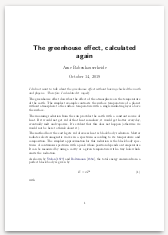How to do X with Emacs Org-Mode
Emacs Org mode keeps me organized. Here I plan to incrementally gather tipps.
full-page images per page for printing via latex eport
Task: create a PDF with full-width images for printing.
#+latex_header: \usepackage[margin=0.0cm]{geometry} #+options: toc:nil # ## upside image ## #+latex: \noindent #+attr_latex: :width 0.9999\textwidth :height 0.9999\textheight :options keepaspectratio=true,angle=90 file:portrait.jpg # ## rotated image ## #+latex: \noindent #+attr_latex: :width 0.9999\textwidth :height 0.9999\textheight :options keepaspectratio=true file:landscape.jpg # ## two images per page ## #+latex: \noindent #+attr_latex: :width 0.9999\textwidth :height 0.495\textheight :options keepaspectratio=true file:landscape.jpg #+latex: \noindent #+attr_latex: :width 0.9999\textwidth :height 0.495\textheight :options keepaspectratio=true file:landscape.jpg # ## keep some space around the images #+latex: \noindent #+attr_latex: :width 0.98\textwidth :height 0.98\textheight :options keepaspectratio=true file:portrait.jpg
Now just export with C-c C-e l p (export to pdf). (the 0.9999 height and width prevent LaTeX from skipping pages)
To turn these into a gallery with 4x4 images per page to cut out the images, you can use pdfnup:
pdfnup --nup 4x4 --no-landscape foo.pdf # creates foo-nup.pdf
agenda-and-todo: my most important planning tool
When I open my Emacs, I hit F12.
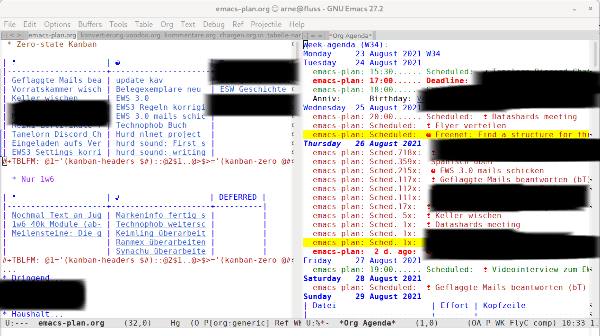
This is what keeps me organized — at home as well as at work. As you can see with the high scheduled count, it isn't perfect, but whenever I skip it, I lose focus. A lifesaver at work, staying ahead of important tasks at home.
It’s a custom agenda combined with kanban.el and optimized TODO states.
Put this into your ~/.emacs.d/init.el to replicate it:
;; KDE: show custom agenda with kanban via f12: (with-eval-after-load 'org (setq org-agenda-custom-commands '(("o" "Agenda and TODOs" ((agenda) (tags-todo "-notodo-TERMIN" ((org-agenda-block-separator ?-))) (tags "KANBAN" ((org-agenda-block-separator ?-) (org-agenda-compact-blocks nil) (org-agenda-overriding-header "")))))))) ;; from https://www.emacswiki.org/emacs/TransposeWindows solution by Robert Bost (defun rotate-windows (arg) "Rotate your windows; with prefix argument to rotate the other direction" (interactive "P") (if (not (> (count-windows) 1)) (message "You can't rotate a single window!") (let* ((rotate-times (prefix-numeric-value arg)) (direction (if (or (< rotate-times 0) (equal arg '(4))) 'reverse 'identity))) (dotimes (_ (abs rotate-times)) (dotimes (i (- (count-windows) 1)) (let* ((w1 (elt (funcall direction (window-list)) i)) (w2 (elt (funcall direction (window-list)) (+ i 1))) (b1 (window-buffer w1)) (b2 (window-buffer w2)) (s1 (window-start w1)) (s2 (window-start w2)) (p1 (window-point w1)) (p2 (window-point w2))) (set-window-buffer-start-and-point w1 b2 s2 p2) (set-window-buffer-start-and-point w2 b1 s1 p1))))))) (defun my/org-agenda-show-kanban () (interactive) (save-excursion (search-forward ":KANBAN:") (org-agenda-goto) (org-narrow-to-subtree) (show-all) (fit-window-to-buffer) (widen) (recenter-top-bottom 0))) (defun agenda-and-todo () (interactive) (org-agenda nil "o") (delete-other-windows) (my/org-agenda-show-kanban) (rotate-windows 1)) ;; systemsettings shortcuts: map f12 to ;; emacsclient -e '(progn (show-frame)(agenda-and-todo))' (global-set-key (kbd "<f12>") 'agenda-and-todo)
To make it look like the screenshot, also set some options in the org-file:
#+STARTUP: overview # TAG TERMIN is excluded from the Kanban table #+TAGS: WOHNUNG(w) RAUS(r) SONST(s) LESEN(l) KANBAN(k) 1w6(1) FAMILIE(f) TERMIN(t) #+STARTUP: hidestars logdone #+SEQ_TODO: ❢ ☯ ⧖ | ✔ DEFERRED # logdone adds a DONE timestamp when switching from a TODO (before |) # to a DONE keyword (after |) # State with (!) behind it means, add a timestamp when switching to that. # See http://orgmode.org/manual/Tracking-TODO-state-changes.html | | | | |---+---+---| | | | | | | | | | | | | #+TBLFM: @1='(kanban-headers $#)::@2$1..@>$>='(kanban-zero @# $# "-TERMIN" 'file)
If you use this, the following could also come in handy:
;; KDE: update all agenda kanban tables with C-S-f12 (ctrl-shift f12) (defun kanban-update-all () (interactive) (cl-loop for i in org-agenda-files do (with-current-buffer (find-file-noselect i) (save-excursion ;; avoid changing the position in the agenda files (beginning-of-buffer) (while (search-forward "='(kanban-" nil t) (org-ctrl-c-ctrl-c)))))) ;; systemsettings shortcuts: map control shift f12 to ;; emacsclient -e '(progn (show-frame)(kanban-update-all))' (global-set-key (kbd "C-S-<f12>") 'kanban-update-all)
create a simple gantt-chart from a table with Gnuplot
Gantt-Charts make it easy to grasp project organization tasks at a glance. If you only need smaller projects with limited scope and 4-6 participants, it is viable to create them directly from an org-mode table.
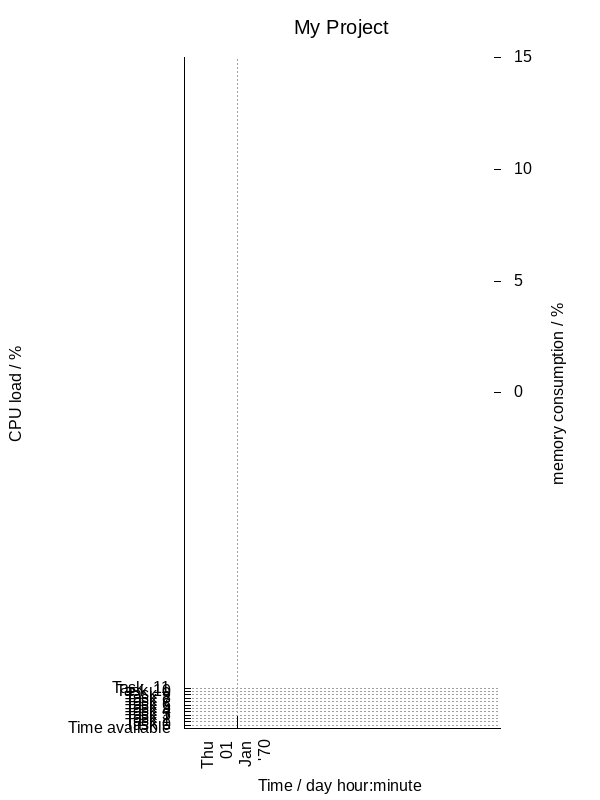
All data is in the following Table:
| Task | Effort | Start | End | Who |
|---|---|---|---|---|
| Time available | 1 | |||
| Task 0 | 2 | Al | ||
| Task 1 | 1 | Bo | ||
| Task 2 | 3 | Ca | ||
| Task 3 | 2 | Ca | ||
| Task 4 | 2 | Bo | ||
| Task 5 | 1 | Bo | ||
| Task 6 | 1 | Bo | ||
| Task 7 | 2 | Al | ||
| Task 8 | 1 | Al | ||
| Task 9 | 1 | Al | ||
| Task 10 | 1 | Bo | ||
| Task 11 | 1 |
the time available row ensures that the whole project-duration is
shown. You need to set the start and end dates manually: Hit C-c .
to enter the calendar and select the date.
The parsing is done by the following code:
reset # http://gnuplot.sourceforge.net/demo_5.1/gantt.html OneMonth = strptime("%m","2") OneWeek = strptime("%U","2") OneDay = strptime("%d","2") timeformat = "%Y-%m-%d %a" T(N) = timecolumn(N,timeformat) set xdata time set format x "%a\n%d\n%b\n'%y" set xtics OneDay nomirror set xtics scale 2, 0.5 set mxtics 7 skiptorow=2 set yrange [(skiptorow-2):] reverse set ytics nomirror unset key set title "{/=15 My Project}" set grid x y set border 3 set style arrow 1 nohead filled size screen 0.02, 15 fixed lt 3 lw 8 plot DATA using (T(3)) : ($0) : (T(4)-T(3)) : (0.0) : yticlabel(1) with vector as 1
You might have to add gnuplot to your active languages:
(org-babel-do-load-languages 'org-babel-load-languages '((gnuplot . t)))
More complex Gantt with plantuml
If you need something more complex, you can go to the full plantuml DSL. Example:
@startgantt
saturday are closed
sunday are closed
' see https://plantuml.com/gantt-diagram
Project starts at 2021-04-26
[Configuration] as [C] on {DEV1:50%} lasts 1 day
note bottom
description
end note
[Implementation] as [I] on {DEV2} lasts 3 days
note bottom
in multiple
lines
end note
[I] starts at [C]'s end with green bold link
{DEV2} is off on 2021-04-30
@endgantt
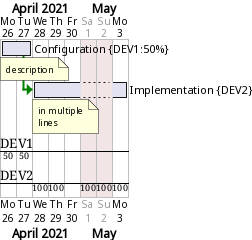
The full source of these examples with the org-mode sourceblocks is available in my website's source-code.
Projects to export gantt from the org-mode tree
export to markdown and latex
(require 'ox-md) #+begin_export markdown # foo __bar__ #+end_export #+begin_export latex \section{foo} \textbf{bar} #+end_export *bar*
run org-capture from commandline
emacs -nw -e org-capture
I call this in the shell via CRTL-r capture ENTER: Search backwards for the last command with capture.
How I stay ahead of tasks with org-mode
I found that org-mode is the only organization tool for which using the tool actually reduces the time I need for organization. That works by taking notes in org-mode, too, and keeping it simple.
I also found that whenever I skip organizing in org-mode, I lose focus and time used (lost?) for tasks extends a lot.
The basics of my setup are:
Custom starting point: agenda-with-kanban
A function to show the agenda it besides the Kanban table. I start each day and after each larger break by hitting F12. It shows me the agenda and entry points into my work. This enables me to stay focussed.
One planning file
I have a single file for all my tasks. That keeps working surprisingly long. Once a year or so it needs some cleanup to become faster again.
Kanban Table at the top
I have a kanban table. It shows as most important information the tasks I am doing right now. If I am doing more than three work-tasks at the same time, it’s warning sign that I’m becoming inefficient. With this I start every day in org-mode by clicking on the link of the project from the kanban table to get to its notes (which I also track in org-mode). See https://www.draketo.de/light/english/free-software/el-kanban-org-table → https://hg.sr.ht/~arnebab/kanban.el
Capture tasks for Projects
Projects have as many tasks as I need to track. At work they are usually Stories (3-5 days). Nowadays I create new tasks by using org-capture templates with one template per larger project and one for bugs, but I used to just use two templates (which might be a better fit for you):
- (i) task to start immediately and
- (l) task to start later
Setup
(with-eval-after-load 'org (setq org-agenda-custom-commands '(("o" "Agenda and TODOs" ((agenda) (tags-todo "-notodo-TERMIN" ((org-agenda-block-separator ?-))) (tags "KANBAN" ((org-agenda-block-separator ?-) (org-agenda-compact-blocks nil) (org-agenda-overriding-header "")))))))) (defun my/org-agenda-show-kanban () (interactive) (save-excursion (search-forward ":KANBAN:") ;; uses the KANBAN tag (org-agenda-goto) (org-narrow-to-subtree) (show-all) (fit-window-to-buffer) (widen) (recenter-top-bottom 0))) (defun agenda-and-todo () (interactive) (org-agenda nil "o") (delete-other-windows) (my/org-agenda-show-kanban) ;; desktop systemsettings shortcuts: map f12 to ;; emacsclient -e '(progn (show-frame)(agenda-and-todo))' (global-set-key (kbd "<f12>") 'agenda-and-todo)
Effort in Clocktable and Columns
To track how much time you need for tasks and train to get better at estimating, you can use org-set-effort. I did that at work for a while.
By having the effort in a clocktable I could see progress when needed.
Hitting R in the org-agenda shows the clockreport-mode and you can see
the Effort in the agenda by customizing
org-agenda-clockreport-parameter-plist (with M-x customize-variable):
(org-agenda-clockreport-parameter-plist (quote (:link t :maxlevel 2 :properties ("Effort"))))
For a while I had the clocktable active by default in the org-agenda.
You can also add that to the column-mode (org-columns) to get a quick overview for a file (leave with org-columns-quit). Customize:
(org-columns-default-format
"%25ITEM %TODO %3PRIORITY %TAGS %17Effort(Estimated Effort){:} %CLOCKSUM")
integrating accounting with ledger into org-mode
If you use ledger-cli for accounting, you can do pretty clever post-processing inside org-mode. Here’s an example that uses –register-format to provide the register results directly as an org-mode table:
#+name: ledger-to-table #+begin_src elisp :var data="" (concat "#+name: ledger-results\n" data "#+tblfm: \n")) #+end_src #+header: :post ledger-to-table(*this*) #+header: :cmdline reg -D --register-format "| [%(format_date(date)) %(payee)] | %(display_account) | %(display_amount) | %(display_total) | \n" --wide --date-format %Y-%m-%d #+begin_src ledger :results raw 2022-06-15 * py2guile Assets:epubli 3.13€ Income:epubli #+end_src
This results in output like this (evaluated live on every export of this website):
(concat "#+name: ledger-results\n" data "#+tblfm: \n"))
2022-06-15 * py2guile
Assets:epubli 3.13€
Income:epubli
| Assets:epubli | 3.13€ | 3.13€ | |
| Income:epubli | -3.13€ | 0.00€ |
To supercharge this, use noweb to re-use your filings for other formats. Set :noweb-ref in the data-block and then use it for other reports. This for example gives todays balance for the different accounts:
#+header: :post ledger-to-table(*this*) #+header: :cmdline bal --wide --date-format %Y-%m-%d --flat --balance-format "| %(partial_account) | %(display_total) | \n" #+begin_src ledger :exports both :noweb no-export :results raw {{{ledger-data}}} #+end_src
{{{ledger-data}}}
This uses direct evaluation and customized noweb-delimiters via:
# Local Variables: # org-confirm-babel-evaluate: nil # org-babel-noweb-wrap-start: "{{{" # org-babel-noweb-wrap-end: "}}}" # End:
Also see
- https://orgmode.org/worg/org-contrib/babel/languages/ob-doc-ledger.html
- https://www.ledger-cli.org/3.0/doc/ledger3.html#Org-mode-with-Babel
Easy signature-block for multiple signatures in org
I’ve long struggled to create simple signature lines, using
\hrulefill, \uline and some of the other options.
But all of these didn’t really match what I wanted, so here’s a simpler version for org-mode:
#+latex: \vfill #+latex_header: \usepackage[ngerman]{babel} % for German-formatted dates #+latex: \newcommand{\pA}{THE NAME 1} #+latex: \newcommand{\dA}{\today} #+latex: \newcommand{\lA}{LOCATION} #+latex: \newcommand{\pB}{THE NAME 2} #+latex: \newcommand{\dB}{\today} #+latex: \newcommand{\lB}{LOCATION} | @@latex:\pA@@ | @@latex:\hspace{1cm}@@ | @@latex:\pB@@ | | | | | | @@latex:\underline{\phantom{\pA}}@@ | | @@latex:\underline{\phantom{\pB}}@@ | | @@latex:\tiny \dA, \lA@@ | | @@latex:\tiny \dB, \lB@@ |
Include an imagemap with a plantuml diagram
Embed a plantuml diagram with clickable links via simple imagemap.
Example

Code
#+begin_src plantuml :noweb-ref plantuml-imagemap-diagram :file plantuml-imagemap-diagram.png title Plantuml diagram with Imagemap hide empty members hide circle ' scale dpi to be small enough so the image does not get scaled, otherwise the imagemap is broken skinparam dpi 72 class link [[#plantuml-imagemap-code]] #skyblue link : to code link -> example #+end_src #+attr_html: :style width:unset;max-width:unset :usemap #plantuml_map #+RESULTS: file:plantuml-imagemap-diagram.png #+html: <div style="visibility: hidden"> #+begin_src plantuml :noweb yes :file plantuml-imagemap-diagram.map :cmdline "-pipemap" :exports results <<plantuml-imagemap-diagram>> #+end_src #+RESULTS: file:plantuml-imagemap-diagram.map #+html: </div> #+begin_src bash :results output html :exports results cat plantuml-imagemap-diagram.map #+end_src
This is a quite contrived hack, but it works. Note that the width must be unset to avoid breaking the imagemap coordinates.
Stackoverflow provides several answers to avoid this limitation in case you want responsive images: Responsive Image Map.
I’m using this in Naming and Logic: programming basics with Wisp and Naming and Logic: programming basics with Guile Scheme.
Single-click time tracking with links
I recently changed teams and in the new team we have to book more precisely. Stuff like Meetings, that I could ignore before. For meetings I don’t start already typing, so I need to click common time tracking issues with the mouse.
But first: “screenshots”! My time tracking interface now looks like this:
| Orga | 🧘 Mein Orga | 📅 Personal | 📅 Kanban (other) | | Proj | 🧰 Apps | 📅 Scrum A | 📅 Scrum B | | | 📚 Reviews | ⏲ clock in LAST | ⏲ clock OUT |
I can click each of the links to activate booking on the respective
task, or switch to it. clock OUT obviously clocks out.
To use this yourself, you have to allow-list the exact links you use.
Customize the variable org-link-elisp-skip-confirm-regexp:
M-x org-link-elisp-skip-confirm-regexp
Put into the text value an adapted version of the following:
^(org-clock-in-last)$\|^(org-clock-out)$\|^(save-excursion (goto-char (org-find-exact-headline-in-buffer "Single-click time tracking with links in org-mode"))(org-clock-in))$\|^(save-excursion (org-id-goto "buchen-orga")(org-clock-in))$
These are strictly limited to the exact functions. Make sure to
include ^ and $ (to prevent people from tacking something to the
end and making that single-click executable) and combine them with
\|. Shorter:
^(org-clock-in-last)$\|^(org-clock-out)$
Here’s a list of the important functions (because I had to track down the last three):
(org-clock-in-last)(org-clock-out)org-id-goto(save-excursion (org-id-goto "buchen-orga")(org-clock-in))
(org-cycle-hide-drawers 'all)org-find-exact-headline-in-buffer
The last one uses:
(save-excursion (goto-char (org-find-exact-headline-in-buffer "TEXT")) (org-clock-in))
(org-id-goto ...) jumps to the entry with the matching ID property.
You can set that with C-c C-x p ID. This way I can have time
recording links in the task name, and adapt them when they change for
the next quarter, but the clickable links still work. These links are
then clickable in the agenda (just click l in the agenda — activate
org-agenda-log-mode — to show the tasks you tracked time on).
(save-excursion ...) prevents visible movement, so the links just
feel like clicking a button even though Emacs underneath navigates to
the headline and clocks in there.
The source of the table is:
| Orga | 🧘 [[elisp:(save-excursion (org-id-goto "buchen-orga")(org-clock-in))][Mein Orga]] | 📅 [[elisp:(save-excursion (goto-char (org-find-exact-headline-in-buffer "Single-click time tracking with links in org-mode"))(org-clock-in))][Personal]] | 📅 [[elisp:(save-excursion (org-id-goto "kanban")(org-clock-in))][Kanban (other)]] | | Proj | 🧰 [[elisp:(save-excursion (org-id-goto "buchen-apps-meetings")(org-clock-in))][Apps]] | 📅 [[elisp:(save-excursion (org-id-goto "buchen-scrum-a")(org-clock-in))][Scrum A]] | 📅 [[elisp:(save-excursion (org-id-goto "buchen-scrum-b")(org-clock-in))][Scrum B]] | | | 📚 [[elisp:(save-excursion (org-id-goto "buchen-reviews")(org-clock-in))][Reviews]] | ⏲ [[elisp:(org-clock-in-last)][clock in LAST]] | ⏲ [[elisp:(org-clock-out)][clock OUT]] |
This now sits below my kanban table in my planning file.
Org-publish setup of draketo.de
The configuration of draketo.de, including the data of the site, is in:
- hg.sr.ht/~arnebab/draketo/browse/setup.el.in and in
- hg.sr.ht/~arnebab/draketo/browse/.emacs.d/init.el
The links on category pages like draketo.de/politik are just the result of shell code blocks run during publishing: hg.sr.ht/~arnebab/draketo/browse/politik.org
Where I want to show some tags, I use a kanban table – for example on draketo.de/software/bsi-grundschutz#todo.
See hg.sr.ht/~arnebab/draketo/browse/software/bsi-grundschutz.org for the source (via hg.sr.ht/~arnebab/kanban.el - also on melpa melpa.org/#/kanban ).
For the layout, see
- hg.sr.ht/~arnebab/draketo/browse/org-templates/level-0-politik.org
- hg.sr.ht/~arnebab/draketo/browse/org-templates/level-0.org
- hg.sr.ht/~arnebab/draketo/browse/org-templates/level-1-politik.org
- hg.sr.ht/~arnebab/draketo/browse/org-templates/level-1.org
Plot a histogram from a table with calculated percentages
This is a complete example: The following table calculates the last
row by removing the AfD-fraction from Gesamt via TBLFM, and PLOT
then creates a histogram.
To do the calculation, move point into TBLFM and press C-c C-c,
then move point into the first PLOT line and press C-c C-c.
#+PLOT: file:"zustimmung-afd-verbot-ohne-afd.png" title:"Meinung zum AfD-Verbot" #+PLOT: ind:1 deps:(2 3 4) type:2d with:histograms set:"yrange [0:]" #+PLOT: set:"style fill solid 0.3" set:"boxwidth 0.8 relative" set:"ylabel 'Anteil / %'" | Gruppe | Ablehnung | Zustimmung | Keine | Anteil | |----------+------------+-------------+--------+--------| | Gesamt | 52% | 27% | 21% | 100% | | AfD | 94% | 5% | 1% | 24% | | Ohne AfD | 39% | 34% | 27% | 76% | #+TBLFM: @4$5=(@2-@3)*100;%.0f%%::@4$2..$4=100*(@2*@2$5 - @3*@3$5)/(@4$5);%.0f%% file:zustimmung-afd-verbot-ohne-afd.png
| Gruppe | Ablehnung | Zustimmung | Keine | Anteil |
|---|---|---|---|---|
| Gesamt | 52% | 27% | 21% | 100% |
| AfD | 94% | 5% | 1% | 24% |
| Ohne AfD | 39% | 34% | 27% | 76% |
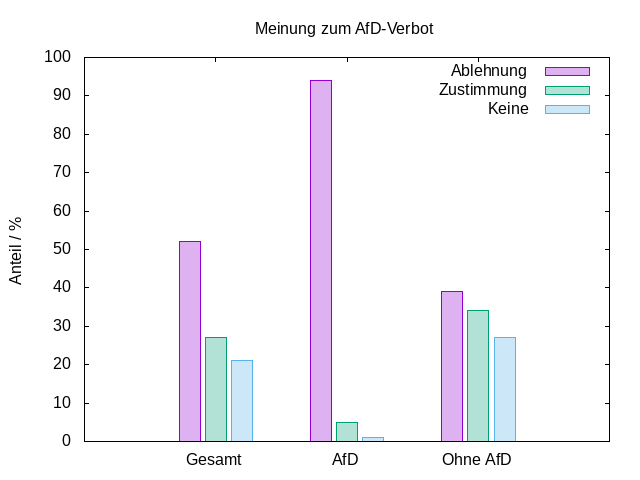
Deploy org-beamer slides to gitlab pages via CI
A minimal setup to turn your org-beamer presentation into a website with the PDF available.
I’m assuming that your presentation is in a file named
PRESENTATION.org (means: replace PRESENTATION by the actual name).
In your repo, create this .gitlab-ci.yml:
pages:
stage: deploy
script:
- mkdir .public
- set -x
- apt-get update && DEBIAN_FRONTEND=noninteractive apt-get -yq install emacs-gtk texlive texlive-latex-extra || true
- HOME="$(realpath .)" emacs --batch -Q -nw --load "$(realpath .emacs)" --find-file "$(realpath PRESENTATION.org)" --execute '(ignore-errors (org-beamer-export-to-pdf))' --execute '(with-current-buffer "*Org PDF LaTeX Output*" (print (buffer-string)))'
- HOME="$(realpath .)" emacs --batch -Q -nw --load "$(realpath .emacs)" --find-file "$(realpath PRESENTATION.org)" -f org-html-export-to-html
- cp -r * .public
- cp PRESENTATION.html .public/index.html
- cp PRESENTATION.pdf .public/
- mv .public public
artifacts:
paths:
- public
rules:
- if: $CI_COMMIT_BRANCH == $CI_DEFAULT_BRANCH
environment: production
And also add in your repo a minimal .emacs:
(require 'org) (require 'ox-latex) (require 'ox-beamer) (require 'ox-html)
To make the lides discoverable, add a line at the top:
#+html: Get the slides: <a href="PRESENTATION.pdf">PRESENTATION.pdf</a>
Now whenever you push your repo to the default branch on gitlab, your presentation will update.
The argument
--execute '(with-current-buffer "*Org PDF LaTeX Output*" (print (buffer-string)))'
ensures that when building fails you get decent error messages.
